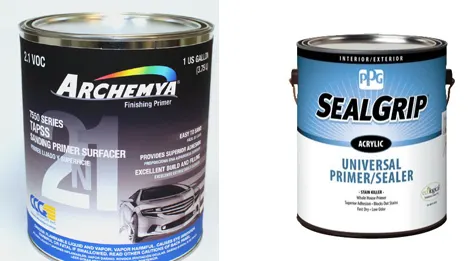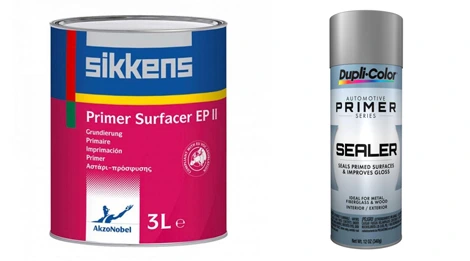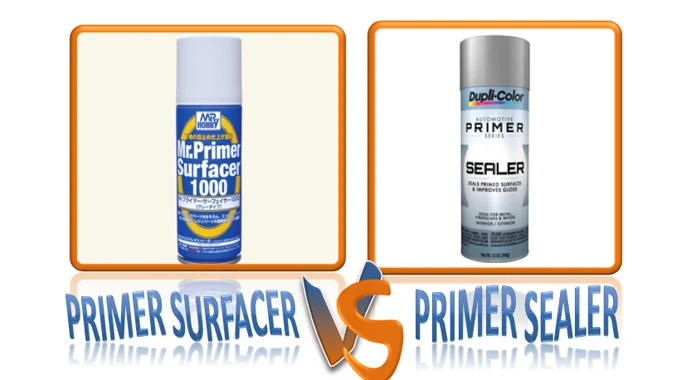Last Updated on August 8, 2023
Primers are the base coat for any automotive sector (particularly the automotive body repair industry) before users apply paint over it. These primers can be categorized as surfacer and sealer. Primer surfacer and primer sealer are both primers, but they serve different purposes.
In this article, we will compare primer surfacer vs primer sealer and help you decide which among the two is best for your next automotive painting project.
What is Primer Surface, And What is Primer Sealer?
Primer surfacer is a type of urethane primer used to repair damages and restore the factory coat. It is available in light gray, orange, black, and clear. After using clear primer, you can use different spray paint colors over them while still maintaining the original color and finish of the car.
On the other hand, most car primer sealers are black, white, grey, or red. The sealer primers are typically used to protect against UV rays and paint degradation. Car manufacturers that produce cars with a clear coat or carmakers with glossy paint usually go for primer sealer over primer surfacer.
Primer Surfacer vs Primer Sealer | What are the Differences?

There are several differences between primer surfacer and sealer. Here are some of these differences:
1. Appearance
The primer surfacer is available in light gray, orange, black, and clear colors. These colors are mainly used for identification and ease of application. For example, light gray or white shades might be used to help visualize coverage, while orange or black might be used for better contrast on certain colored vehicles.
Most car primer sealers come in black, white, grey, and red colors. These colors are chosen for their ability to complement a wide range of topcoat colors. For instance, black, white, and grey sealers are neutral and can work well with various paint colors, while red sealers may be used when applying specific red or dark-colored topcoats.
Car owners who need a better paint finish can use sealer primers as the base coat, but car companies that produce cars with clear coat paint should go for a primer surface, as it provides a rougher surface that enhances the adhesion of the paint.
2. Adhesive
Primer surfacer has a stronger adhesive that allows it to hold onto any surface, even-textured ones. Carmakers use primer surfacer as an adhesive coat to restore old parts or used auto bodies back to their original factory finish before they are primed again using primer-sealer. Car owners can use primer surfacer to different bond parts, such as bumpers and quarter panels.
3. UV Protection
Truck owners, mainly those that travel long distances, need a primer surfacer because this type of primer contains UV protection to prevent the paint from peeling. Car users can use primer-sealer to protect against UV rays for added gloss and shine.
4. Durability
Primer surfacer is more durable than sealer primer. Car owners who need a stronger and longer-lasting paint exterior can use a primer surfacer. Car manufacturers also coat different car parts with the surface to make them stronger and more durable.
Car owners who want their cars painted red, yellow, or orange colors should go for prime surfacer. Surfacer over sealer primer is also recommended for auto owners without a need for protection.
5. Paint Compatibility
Primer surfacer is compatible with all kinds of automotive paint, including acrylic and enamel. Car owners can use sealer primer as the base coat for topcoats over car exteriors. Carmakers that want to apply colors immediately after priming should use sealer primer because it dries faster than surfacer.
When Should You Use a Primer?

Auto Primer surfacer is used as the first coat of paint. It has a rougher surface which allows car owners to apply different layers of top coats on top of it. Carmakers use primer surfacer to restore old parts to their original factory finish before they are primed again using sealer primers.
Primer sealer is applied as the second coat of paint to protect car exteriors from damage due to ultraviolet radiation rays. It also adds gloss and shine to the car exterior. Car manufacturers use filler primer-sealer when they want immediate color changes or produce cars with clear coats or semi-glossy paint finish.
Which One is Better for You?
Primer surfacer has a stronger adhesion than primer-sealer, so it is better for car owners who want their cars to have different color paint jobs. Carmakers also use primer surfacers as an adhesive coat for old parts, so car owners should only go for surfacer if they plan to restore their old car components to a factory finish. Car manufacturers utilize sealer primer as the base coat for clear coats.
Pros and Cons of Each Primer:
Surfacer Primer:
PROS:
- Provides a rougher surface that allows car owners to apply different coating layers to it
- Made from stronger adhesive
- It makes old car parts have better adhesion compared to their original factory finish
CONS:
- Requires more than one coat of old paint to get rid of the orange peel effect
- More expensive compared to sealer primer
- Does not dry up fast, so car owners who want their cars painted immediately should use this type of primer
Sealer Primer:
Pros:
- It has a smoother metal surface, dries faster, and is cheaper than surfacer primer
- It does not have an orange peel effect due to multiple coating layers
- Provides UV protection for car exteriors, making it more durable
Cons:
- It cannot be used as an adhesive coat because it is less durable compared to surfacer primer. Car owners need to use surface, perhaps after one or two years of using sealer primer as the second topcoat.
- It does not provide a rougher surface that car owners can use to apply multiple layers of top coats on it.
- Less adhesive compared to surfacer primer.
How to Choose the Right Type of Primer for Your Project?

Here are some guidelines for choosing between surfacer and sealer primer:
- Car owners need to determine whether their car exteriors are painted in matte, glossy, or semi-glossy colors.
- If they are painting their cars red, yellow, or orange colors, then primer surfacer is best for them.
- Primer sealer is recommended if you plan to change the color of your car often and if you want your car painted in semi-glossy colors.
- Car owners who plan to paint their cars matte or glossy colors can use either surfacer or sealer primer, as long as they properly prepare the surface of the old parts first before applying any primer.
- They should also check for dents and scratches on the car body before priming it. Both automotive primer surfacer and sealer primer can cover minor scratches on the car exterior, but they cannot wholly remove major paint damages.
FAQs
How Long Does It Take for Primer to Dry?
Surfacer primer requires at least 30 minutes to 1 hour of drying time. Sealer primer, on the other hand, dries up to 3 hours.
Can You Paint Over Surfacer After It Has Dried?
Yes, you can apply topcoats of auto paint on the surfacer after drying up. It is also best to sand the surface lightly before brushing on topcoats of paint.
Can You Apply Sealer Primer Over Already Dried Surfacer?
Yes, you can brush on another coat of sealer primer over dried surfacer. Just make sure that the previous coat is completely dry, or else it will mix up with the new layer and create a bumpy surface.
Conclusion
Primer surfacer and primer sealer are both primers that can be used to prepare the surface for painting. They have their own unique benefits and drawbacks, which car owners need to consider when choosing between the two. The bottom line is that it all depends on the car owner’s preference and because different jobs need different types of primers.

i have repared a dent on my metallic red fender and do not know which primer to use,a primer surfacer or sealer before the top coat?
Please use Sealer Primer.
should i use a primer sealer or surfacer before a fender repaint?
Sealer Primer
i’m trying to paint my truck. which should i use? primer sealer or primer surfacer?
Please use sealer.